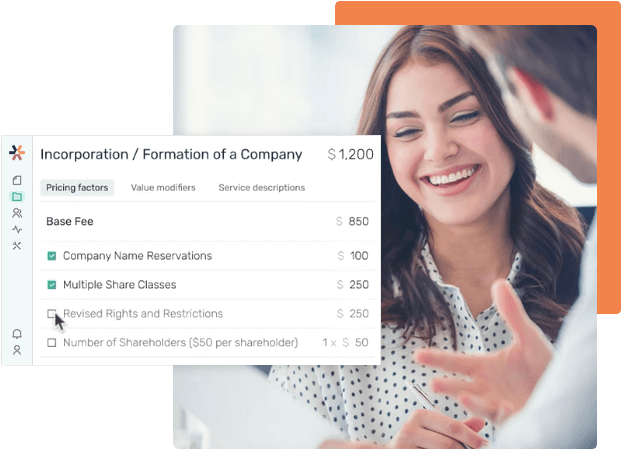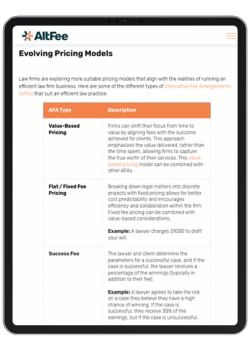- Resources
- 4 Solutions to Law Firm Time and Billing Software Challenges
Table of Contents
Even in today’s day and age, the billable hour still lingers as a prevalent model for charging clients for legal services, even though the conversation surrounding the efficacy of the billable hour is definitely changing.
But even as the billable hour has lawyers be running up that road, be running up that hill, be running up that building to meet with clients as quickly as possible to reduce their non-billable time, it doesn’t stop them from having to work 70-80 hour work weeks to meet billable hour expectations set by their law firm.
Ok, maybe the billable hour wasn’t exactly what Kate Bush was referring to when she wrote Running Up That Hill (A Deal with God) but really, most seasoned lawyers probably wouldn’t mind swapping places with someone that doesn’t have to deal with the inefficiencies of time tracking, and the billable hour.
Thankfully, we’re no longer in the 80s and there are legal technology solutions, such as timekeeping and billing software for lawyers, that can actually make the process of tracking time more accurate, efficient, and most importantly, less painful.
Defining Law Firm Time and Billing Software
Legal time billing software allows lawyers to accurately track the time they spend working on legal services for their clients, and subsequently use that tracked time to easily create invoices.
Since time tracking and billing go hand in hand, it makes sense that the legal software world would create law firm time and billing solutions that allow legal professionals to seamlessly move from tracking their time to creating a bill for a client.
But law firm time and billing software shouldn’t be confused with law firm pricing software, which is typically a separate solution, although the two can work in tandem with each other.
The following table outlines the differences between the law firm pricing and law firm time and billing software:
|
Law Firm Pricing Software |
Law Firm Time & Billing Software |
|
Determines the cost of a legal service before the work starts |
Handles invoicing the client once legal work is complete |
|
Allows legal professionals to set out standard prices for different legal matters in advance, and adjust them based on client needs |
Helps a legal professional track their time for a project, and then uses that time with invoice creation |
|
Often allows scoping and pricing templates to be created for different legal matters |
Helps reduce the administrative burden of manual time tracking and invoicing |
Challenges of Legal Time Billing
The “billable hours law firm” has been standard practice in the legal industry for decades, with lawyers needing to accurately track their time to charge their clients a fair price for their legal services. But just because the billable hour has been a standard for so many years doesn’t mean that it doesn’t come with its fair share of challenges.
On the contrary, the many challenges of the billable hour have recently come to light, with many more law firms looking to switch to alternative options.
Some of the challenges of legal time billing include:
- Lawyers being tempted to spend as much time on a task as possible
- Law firms set unreasonable billable hour targets to gain more profit, leading to lawyer burnout
- Time tracking does not necessarily equal value
- Poor time tracking habits can be costly for a law firm
Let’s explore these challenges in more detail:
Lawyers are Tempted to Spend as Much Time on a Task as Possible
If you don’t know anything about cars and you go to a mechanic to get your vehicle repaired and the mechanic says it’ll take 4 hours, there’s little reason why you would question that estimate. After all, the mechanic is the professional car fixer, so who are you to say how long a job will or will not take?
It’s a similar story with lawyers. Clients are hiring lawyers because of their expertise and skill in handling the complexities of the law, and so even with an itemized bill, the client has no way of knowing exactly how much time a task should take. To complicate it further, the lawyer’s experience and expertise in a particular area of the law may cause a task to take more or less time.
Sure, there are regulations surrounding time tracking, but unfortunately, the language is ambiguous, saying only that the fees must be “fair” and “reasonable”, with little clarification and further explanation. This ethical ambiguity opens up all sorts of potential issues.
One example from Verdict discusses a lawyer that claimed to work 5,941 billable hours per year for four years in a row. Since a year only includes 8,760 hours, it’s very clear that this isn’t an accurate representation of this lawyer’s workload, because they’d have to work 16+ hours per day every single day of the year, including holidays. One would wonder how this lawyer was able to get away with this billing structure for four years, but as the article points out, the increased income for the law firm was perhaps a reason behind it.
Also, it’s not like lawyers always intentionally want to charge their clients more for a provided legal service. A lawyer could be incentivized to add more time to a client’s bill to increase profits for their law firm. The only way for an attorney to be profitable under the billable hour model is to bill enough hours to not only cover their salary but to turn a profit for the law firm (so they can keep their job).
Unreasonable Hourly Targets Lead to Lawyer Burnout
According to the 2018 Clio Legal Trends Report, 75% of the lawyers surveyed frequently worked outside of regular business hours. In addition, lawyers work, on average, 140 additional unplanned hours every year, which amounts to around 3.5 weeks of extra work a year.
In the United States, larger firms maintain billable hour targets of 1,850 to 2,000 hours per year, but it isn’t uncommon for “higher-performing” associates to bill 2,200 hours or more. To even get to 1,800 hours a year, the lawyer would have to work 10-10.5 hour days (assuming 5 weeks of vacation) to account for non-billable time spent doing other things (breaks, lunch, meetings, etc.) which would mean working about 2,420 hours per year. This means you’re at least billing 37.5 hours a week, or 7.5 hours per day. If you’re aiming for higher targets, that means working even longer days, adding hours over the weekend, or cutting into your vacation time.
Tracking Time is a Counterintuitive Measure of Value
Just because a lawyer spends more time on a case doesn’t necessarily mean that they’ve done a better job. The idea that time = value is not exactly the most meaningful way to determine bang for your buck. Instead, 78% of clients want to understand the value of legal services by seeing pricing models that marry affordability with value, which typically goes beyond the hourly billing model and leans more towards alternative billing options, like flat fees, subscription-based fees, and more.
Poor Time Tracking is Costly
When you’re tracking your time in as little as 6 minute-increments, it may seem like keeping track of how much time a task takes isn’t really an issue, but the reality is the opposite. Imagine realistically trying to time yourself for every single task you do — writing emails, talking on the phone, researching a legal matter — it’s tough to be absolutely exact. Lawyers are also busy, so filling out timesheets can feel like just another annoying administrative task that adds unnecessary time to an already full day. Imagine taking 3 minutes to write an email, and then having to take an additional 3 minutes to fill out your timesheet for that email — like we said, annoying.
Waiting until the end of the day to fill out your timesheet is one option, but it often results in inaccuracies in trying to remember how long each task took you to complete. Lawyers recording their time at the end of the day can cost 10-15% of their potential billable hours while waiting 24 hours can cost up to 25% of billable time, and waiting until the end of the week can cost up to 50%.
4 Solutions to Legal Billing Challenges
Thankfully, there are some solutions that law firms can implement to counteract common legal billing challenges. Here are some options:
1. Using Alternative Fee Arrangements
The first solution to legal billing challenges is simply not to use the hourly billing model. That might seem presumptuous at first, but when you look at the conversation surrounding it today, it makes more sense to switch:
- The industry is shifting to support more client-centric law firms, and clients want cost certainty with their legal services
- Alternative fee arrangements help legal professionals communicate their value to clients more effectively by pricing legal services based on expertise, experience, and more rather than a straight hourly rate
- Using AFAs helps law firms provide better working conditions for their professionals, as there’s less or no focus on meeting billable hour targets
In short, AFAs give law firms more flexibility with billing clients, and at the same time give clients more transparency and clarity when it comes to legal services pricing. When clients have price certainty at the beginning of the transaction, it’s much more likely that they’re going to pay their bill at the end which contributes to a higher collection rate. With an AFA pricing system in place, lawyers gain confidence when presenting pricing to clients. It also helps increase law firm billing metrics such as realization rate through the implementation of improved systems and a focus on efficiency.
2. Adopting Legal Time and Billing Software
These days, legal software provides law firms with countless ways to streamline their workflows, processes, and overall operations. Adopting legal time billing software means that legal professionals no longer have to manually track their time, and instead can simply click a button in the software or tap start on their smartphone to keep track of their billable and non-billable hours. For billable hours, time and billing software for lawyers can usually be tracked per legal matter deliverable, meaning it's easy to see how much time each type of task takes to complete. The hours are then saved and transferred to an invoice template to make billing clients faster and easier.
3. Automate Invoice Creation
Many law firm time and billing software offerings provide a way to take billable hours and transfer them automatically to an invoice, reducing the administrative work that would typically be required to manually fill out an invoice for each client. If the software integrates with a customer relationship management (CRM) system, then the lawyer may not even have to fill out the client’s name or contact information, the time and billing software for lawyers can automatically pull it from the database.
4. Use UTMBS and LEDES Codes to Easily Categorize Legal Billing Tasks and Expenses
In an effort to make billing easier for legal professionals and provide more billing transparency for clients, the UTMBS and LEDES standards were developed.
- UTMBS, which stands for Uniform Task-Based Management System, is a set of standardized code sets that aim to make legal billing much easier and more recognizable to both legal professionals and clients.
- LEDES codes are specifically designed for electronic billing or e-billing, as these days, most clients prefer to receive digital bills.
Most law firm time and billing software include support for these codes (Clio is one example) to make it easy to create standardized invoices, and eliminate the need for law firms to come up with their own terminology for legal services billing.
Considerations When Selecting Legal Pricing Software
Now that we’ve talked quite a bit about legal time and billing software, let’s take a look at the other side of the coin: legal pricing software. After all, pricing and billing go hand in hand. You can’t very well bill clients for legal services if you don’t have an effective pricing strategy to back up your invoices.
But when it comes to selecting the right legal pricing software solution that will work for you, it’s important to keep several considerations in mind:
- Ease of use. If the software is too convoluted and difficult to figure out how to use, then the chances of your legal professionals using it will be low. Poor user experience, in general, has been tied to less employee buy-in when it comes to using that software on a daily basis.
- Innovation/future-proofing. You don’t want to choose a piece of software only to have future development halted a few months later. Research the software offering first to see if they have a future development plan in place, or at least have a reputation for continually improving and innovating their product.
- Customer support. Whether or not a company provides good customer support can often be a deal or no deal type of scenario as to whether you should give them your business or not. It’s nice to be able to get technical support and have someone to answer questions on demand, especially if your law firm is heavily relying on a piece of software.
- Product features. Before you land on a legal pricing solution, think about what you want the software to do to solve the current issues your firm is having with pricing, and match those with the software features. For example, you might want the ability to collaborate with others within your law firm to determine pricing for different projects, without having to leave the software. Pricing software also gives your law firm the ability to have all priced projects in one centralized location for easy access. Make a list in advance and compare it to your choices, and go with the one that ticks as many boxes as possible.
- Price. Maybe you have a budget, or maybe you’re willing to spend however much it costs to get the solution you need. Regardless, you should be aware of the typical price for legal pricing software.
Recommended Law Firm Software
Before we continue with our recommendations, it’s important to note that a lot of legal software seems to focus on multiple solutions at the same time, combining practice management, billing, and client engagement features into one piece of software, so many of the solutions we’re recommending below can do multiple things.
While time tracking is still a standout feature for most of these software offerings, it’s important to realize that it doesn’t always have to relate to the billable hour; particularly from a firm management perspective, tracking your time can be important (although maybe not to the 6-minute increments that are often expected with the billable hour) to gain data on how much time it’s taking legal professionals to complete projects, even if you’re billing clients using alternative fees.
Our recommendations for top law firm software to improve your firm’s pricing and billing systems include:
- AltFee
- Clio
- Smokeball
- GhostPractice
Let’s get into more detail about our recommendations:
|
Software Type |
Legal Pricing Software |
Description |
Price |
|
Pricing |
As one of the only legal pricing software solutions out there that focuses exclusively on AFAs, AltFee allows your law firm to take a collaborative approach to matter pricing. Straightforward and easy-to-use software allows you to select pre-done matter templates to modify or create your own from scratch. |
USD $39 per user per month, which includes 50-priced projects. |
|
|
Legal Management |
Clio is very well known in the legal industry as software that offers a variety of features, from case management to time tracking, billing, and much more. With regards to time tracking, the features are robust, allowing you to record work in real-time from your phone or computer, and edit it later as needed. |
Starts at USD $39 per user per month. |
|
|
Automation |
As a cloud-based legal productivity software solution, Smokeball aims to reduce the hassle of time tracking by completely automating it. In addition, it provides robust insights with its profitability analysis and AI, allowing you to gain the information you need to make data-driven decisions regarding pricing for your law firm. |
Starts at USD $29 per user per month. |
|
|
Time Tracking |
As practice management software with an easy-to-use time tracking solution GhostPractice not only allows automatic time tracking, but also integrates with Outlook, Word, and Excel. |
You must contact GhostPractice directly for pricing. |
* Pricing as of June 2022
Conclusion
The billable hour may still be hanging on for dear life in the legal industry, but thankfully alternative options are becoming more and more common as both legal professionals and clients demand a better approach to the pricing of legal services.
These days, law firm time tracking and billing software are also available to soften the administrative blow that comes with needing to manually track your time. Many options offer automatic time tracking, as well as the ability to transfer that tracked time to an automatically generated invoice.
Even if your law firm doesn’t use the traditional billable hour, you’ll still likely find that time tracking has a place. Being able to effectively track time helps you determine how long projects in your firm are taking, and make adjustments to expectations, matter pricing, and more based on that data.
Since pricing goes hand in hand with billing, having a pricing strategy to determine what you’ll charge clients is important for billing consistency, and ensuring that everyone in your firm understands what is billed to a client and what is not.
If you’re ready to get started with the creation of a pricing system for your law firm, reach out to AltFee today to get a demo of our software.
Start Earning More Revenue with Fixed Fees
Break free from hourly pricing and take the fear out of scoping and pricing client projects to start maximizing profitability.
Book A Demo







Newsletter Signup
Subscribe to our newsletter to receive the latest news.



